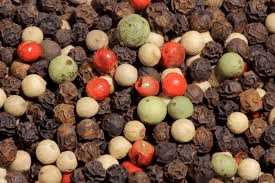
Pepper
Pepper owes its bite to an alkaloid called piperine, and its warm, woody, sometimes citrus like flavour. This from several essential oils.
The balance of these essential oils and piperine vary according to the origin of the spice. Indian Malabar is reputedly the best with its balanced blend of bite and aroma. Indonesian lampong has more bite and less aroma. Malaysian Sarawak has even less aroma. While Brazilian and Vietnamese generally contain less piperine, making them less pungent. Of the several forms of pepper available to modern cooks, black is by far the most common. It is produced by picking the berries when they are still green, fermenting them briefly, and then drying them. In the course of fermenting and drying, the berries shrink and the skin becomes black or dark brown and wrinkled. The skin is where many of the essential oils are located, giving black pepper its unique aroma and flavour.
The Berries
White pepper is the inner core of berries that have been picked when they are yellow-orange and almost ripe. They are soaked briefly to soften the outer skin, which is then removed. Without this outer skin and its oils, white pepper is almost without aroma, and with piperine to provide the bite. Its flavour is considered flat and uninteresting by many. It is often used in cream sauces in order to avoid the visible black specks that black pepper would provide. The best white pepper is said to be Muntok from Indonesia.
Green peppercorns are picked green and freeze fried or pickled in brine or vinegar. They have less bite than other forms and add an agreeable fresh note. Red peppercorns (not to be confused with pink pepper) are picked ripe and treated the same as green peppercorns. They have a delicate sweet, fruity taste, but are not widely available outside of Southeast Asia.
